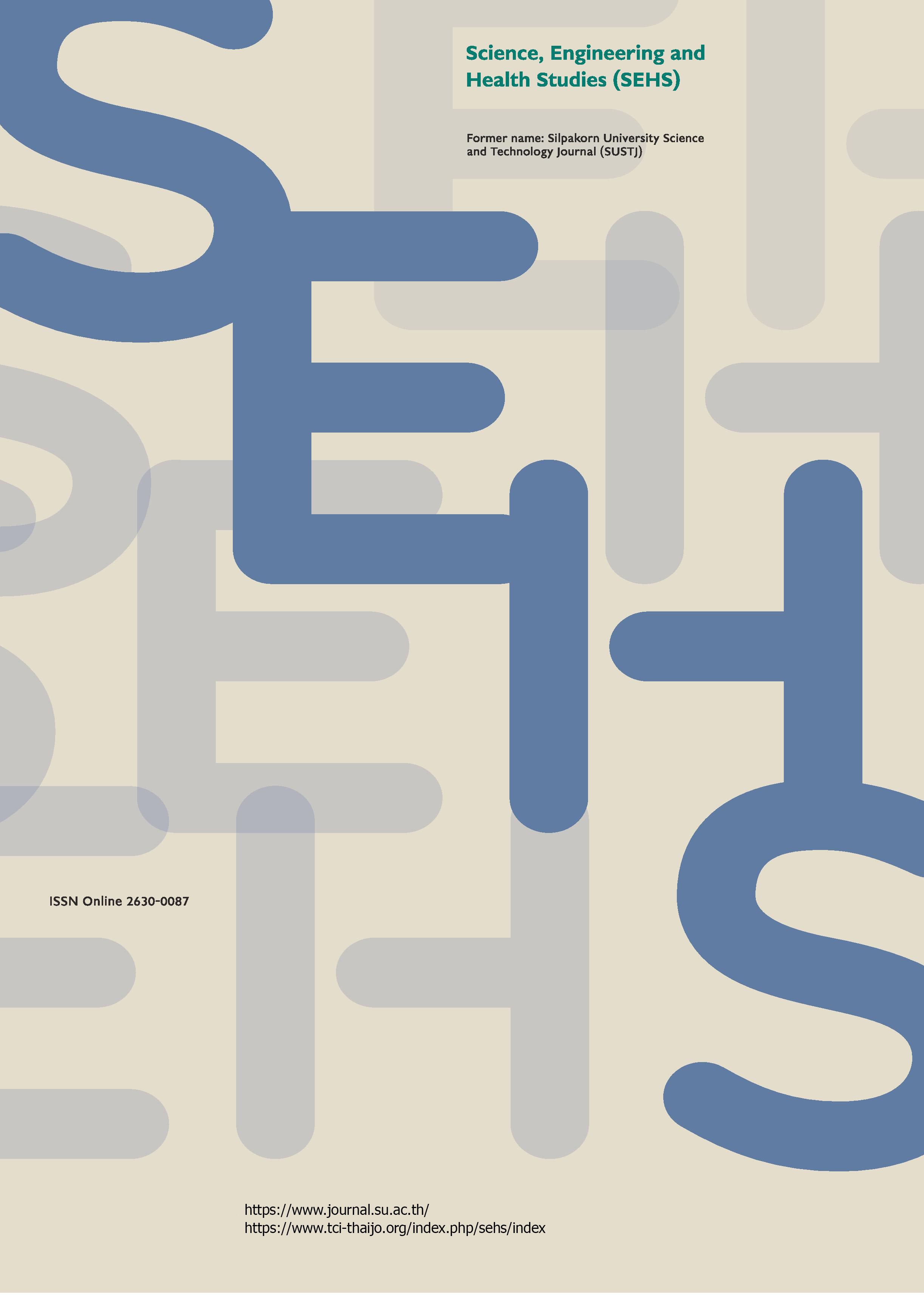Alteration in cardiac autonomic activity during listening to Thai classical music in male subjects
Main Article Content
Abstract
Relaxing music, such as classical music, could improve autonomic nervous system function by reducing sympathetic activity and increasing parasympathetic activity, as indicated by an increase in heart rate variability (HRV). However, it is unknown whether Thai classical music, which is considered to be relaxing music, could induce autonomic alterations. This study investigated the effects of classical, heavy metal, and Thai classical music on cardiac autonomic activity, as determined by HRV, using a crossover design methodology. All subjects were exposed to the three music stimulations. Electrocardiograms (ECGs) were recorded before, during, and after music listening. The results showed that the standard deviation of normal-to-normal R-R intervals (SDNN) and low frequency (LF) power were significantly decreased during listening to Thai classical music. The decreased SDNN might be due to a reduction in parasympathetic activity, as indicated by the reduction in root mean square successive difference (RMSSD) and percentage of subsequent R-R intervals with a duration difference longer than 50 ms (PNN50). However, the decrease in parasympathetic activity was not large enough to induce autonomic imbalance as shown by an insignificant change in high frequency (HF) power. A positive correlation between LF power and HF power was also observed during listening to Thai classical music. This suggests that HF power functioned to counterbalance the change in LF power during the listening session. In conclusion, only Thai classical music affected cardiac autonomic function by decreasing sympathetic activity without altering cardiac autonomic balance.
Downloads
Article Details

This work is licensed under a Creative Commons Attribution-NonCommercial-NoDerivatives 4.0 International License.
References
Bernardi, L., Porta, C., and Sleight, P. (2006). Cardiovascular, cerebrovascular, and respiratory changes induced by different types of music in musicians and non-musicians: The importance of silence. Heart, 92(4), 445–452.
Carnevali, L., Trombini, M., Graiani, G., Madeddu, D., Quaini, F., Landgraf, R., Neumann, I. D., Nalivaiko, E., and Sgoifo, A. (2014). Low vagally-mediated heart rate variability and increased susceptibility to ventricular arrhythmias in rats bred for high anxiety. Physiology and Behavior, 128, 16–25.
Chevalier, G., and Sinatra, S. T. (2011). Emotional stress, heart rate variability, grounding, and improved autonomic tone: Clinical applications. Integrative Medicine, 10(3), 16–21.
Chuang, C. Y., Han, W. R., Li, P. C., and Young, S. T. (2010). Effects of music therapy on subjective sensations and heart rate variability in treated cancer survivors: A pilot study. Complementary Therapies in Medicine, 18(5), 224–226.
da Silva, S. A. F., Guida, H. L., dos Santos Antonio, A. M., de Abreu, L. C., Monteiro, C. B., Ferreira, C., Ribeiro, V. F., Barnabe, V., Silva, S. B., Fonseca, F. L., Adami, F., Petenusso, M., Raimundo, R. D., and Valenti, V. E. (2014). Acute auditory stimulation with different styles of music influences cardiac autonomic regulation in men. International Cardiovascular Research Journal, 8(3), 105–110.
Floras, J. S., and Ponikowski, P. (2015). The sympathetic /parasympathetic imbalance in heart failure with reduced ejection fraction. European Heart Journal, 36(30), 1974–1982.
Hall, M., Vasko, R., Buysse, D., Ombao, H., Chen, Q., Cashmere, J. D., Kupfer, D., and Thayer, J. F. (2004). Acute stress affects heart rate variability during sleep. Psychosomatic Medicine, 66(1), 56–62.
Iwanaga, M., Kobayashi, A., and Kawasaki, C. (2005). Heart rate variability with repetitive exposure to music. Biological Psychology, 70(1), 61–66.
Iwanaga, M., and Moroki, Y. (1999). Subjective and physiological responses to music stimuli controlled over activity and preference. Journal of Music Therapy, 36(1), 26–38.
John, N., Dubey, P., and John, J. (2021). Impact of instrumental music on heart rate variability in ardent music listeners. Research in Cardiovascular Medicine, 10(1), 14.
Kurita, A., Takase, B., Okada, K., Horiguchi, Y., Abe, S., Kusama, Y., and Atarasi, H. (2006). Effects of music therapy on heart rate variability in elderly patients with cerebral vascular disease and dementia. Journal of Arrhythmia, 22(3), 161–166.
Lee, D., Henderson, A., and Shum, D. (2004). The effect of music on preprocedure anxiety in Hong Kong Chinese day patients. Journal of Clinical Nursing, 13(3), 297–303.
Lee, O. K. A., Chung, Y. F., Chan, M. F., and Chan, W. M. (2005). Music and its effect on the physiological responses and anxiety levels of patients receiving mechanical ventilation: A pilot study. Journal of Clinical Nursing, 14(5), 609–620.
Lynar, E., Cvejic, E., Schubert, E., and Vollmer-Conna, U. (2017). The joy of heartfelt music: An examination of emotional and physiological responses. International Journal of Psychophysiology, 120, 118–125.
Malik, M. (1996). Heart rate variability: Standards of measurement, physiological interpretation, and clinical use. Annals of Noninvasive Electrocardiology, 1(2), 151–181.
Malpas, S. C. (2010). Sympathetic nervous system overactivity and its role in the development of cardiovascular disease. Physiological Reviews, 90(2), 513–557.
Plassa, B. de O., Milan, R. C., Guida, H. L., de Abreu, L. C., Raimundo, R. D., Gonzaga, L. A., and Valenti, V. E. (2014). Cardiac autonomic responses induced by auditory stimulation with music is influenced by affinity. Medical Express, 1(14), 206–210.
Salimpoor, V. N., Benovoy, M., Larcher, K., Dagher, A., and Zatorre, R. J. (2011). Anatomically distinct dopamine release during anticipation and experience of peak emotion to music. Nature Neuroscience, 14, 257–262.
Shrihari, T. G. (2019). Beta endorphins-Holistic therapeutic approach to cancer. Annals of Ibadan Postgraduate Medicine, 17(2), 111–114.
Steptoe, A., and Kivimäki, M. (2012). Stress and cardio-vascular disease. Nature Reviews: Cardiology, 9, 360–370.
Thayer, J. F., Yamamoto, S. S., and Brosschot, J. F. (2010). The relationship of autonomic imbalance, heart rate variability and cardiovascular disease risk factors. International Journal of Cardiology, 141(2), 122–131.


